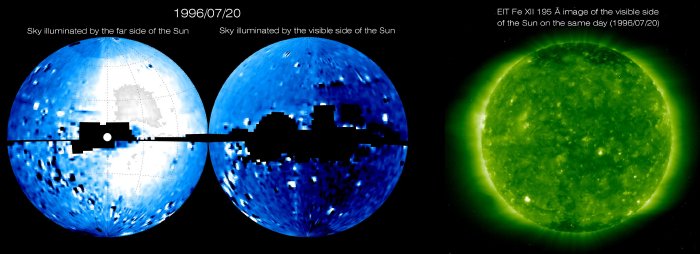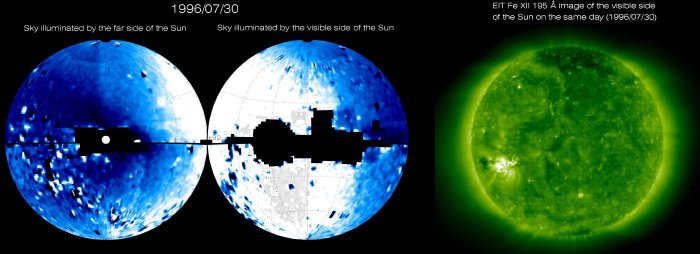Glimpsing the far side
|
Click on the images for larger versions. |
 |
 |
Full-size images: top,
bottom |
Caption: Scientists have found that they can peek around the Sun and predict whether solar storms on its far side will shortly appear on the side facing the Earth. This surprising discovery by SOHO's SWAN instrument could help to predict the solar storms that sometimes threaten the Earth.
Using the ESA/NASA Solar and Heliospheric Observatory (SOHO), the researchers have seen hot-spots as they light up a cloud of hydrogen atoms in space with strong beams of ultraviolet light. This moving glow in the sky (invisible from Earth) could give several days' warning of an active region on the Sun's surface that will come into view as the Sun rotates.
SWAN, short for Solar Wind Anisotropies, is used to map the whole sky in ultraviolet light. It sees a huge cloud of interstellar hydrogen that bathes the entire Solar System and interacts with the solar wind. The cloud is relatively tenuous - about 100 atoms per litre - yet it is thick enough to shine when illuminated by the Sun's ultraviolet light.
This kind of observation is impossible from Earth because the atmosphere completely filters the short-wavelength ultraviolet light. Even spacecraft in orbit around the Earth are blinded to the hydrogen haze of the Solar System by a large swarm of hydrogen atoms that surrounds our planet.
But that's not the case for SWAN - one of 12 instruments aboard SOHO, which operates from a special vantage point 1.5 million kilometres out in space, on the sunward side of Earth. The SWAN scientists detect hot-spots when the hydrogen cloud beyond the Sun glows more strongly than would be expected if the Sun were uniformly bright on its far side.
"Strong ultraviolet emissions from active regions on the back of the Sun behave like beams from a lighthouse on the landscape," says Jean-Loup Bertaux, of the CNRS Service d'Aéronomie in France, and principal investigator for SWAN. "They move in the sky in accordance with the Sun's rotation," which takes about 28 days. "We can monitor the activity on the back side of the Sun without looking at it directly. This method could be used in future studies on space weather, which can seriously affect orbiting satellites and other technological systems on Earth."
Links:
Instruments: SWAN (Solar Wind ANisotropies); EIT (Extreme ultraviolet
Imaging Telescope);
Picture credit: SOHO/SWAN and SOHO/EIT (ESA and NASA)


